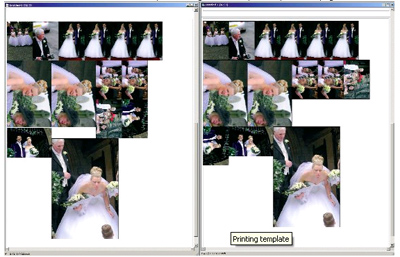articles/Printing/simpleprinting-page3
Simple Printing? - Printing Simplified? - part 3 of 1 2 3 4
by Mike McNamee Published 01/10/2004

Images may be placed on the page free style (left) or auto aligned for trimming (right).
One of the most common tasks in a digital workflow is the organising of multiple prints at various sizes and different call-offs. Typically at the end of a wedding shoot you may be faced with an order for say 6 off 10x8, 3 off 4x5 and one each of images numbered 001 to 015. Printing each of these individually would be both time consuming and, on a roll printer, wasteful of media. The solution is to nest the images onto a single larger piece of paper and print in one go, followed by (hopefully) easy trimming along the long runs of borders. Traditionally the nesting function has been part of Raster Image Processing (RIP) software. However RIPs also provide a host of other features and are as expensive or even more expensive than the printer itself. Epson PageProofer provides a nesting facility for use on inkjet printers without resorting to a fully featured RIP and an attendant reduction is cost.
The software is simple. You start by making a page size of your choice, often some convenient length off a 24" or 17" roll of paper. You then click "get images" and navigate to the place where you images are stored. You then make a selection of images and drop them onto the page[1]. As they are placed they arrange themselves in the best orientation. You can call up default sizes, chosen sizPrinting templatees or reductions and duplicate images when required. If you fill the page a new one is started automatically. You can review at low resolution and uncorrected colour or soft proof your assembled page on an image-by-image basis. There is also a facility to employ the EXIF data to correct an image, which worked excellently for making quality proofs. Facilities are also available to add captions and file names when creating "contact sheets".

There are 5 simple boxes to attend to and the setting remain sticky
High level colour management may be applied including the icc input and output profiles, rendering intents and output simulations to presses.
Qimage
Terry Hansen wrote about Qimage some time ago. It is a program that he has used extensively and is very pleased with. Overall it functions in a similar manner to PageProofer but includes some additional features such as slide shows and built-in image adjustment. It is a simple program to use including the setting up of your chosen colour management features.
Please Note:
There is more than one page for this Article.
You are currently on page 3
- Simple Printing? - Printing Simplified? page 1
- Simple Printing? - Printing Simplified? page 2
- Simple Printing? - Printing Simplified? page 3
- Simple Printing? - Printing Simplified? page 4
1st Published 01/10/2004
last update 09/12/2022 14:58:56
More Printing Articles
There are 0 days to get ready for The Society of Photographers Convention and Trade Show at The Novotel London West, Hammersmith ...
which starts on Wednesday 15th January 2025





